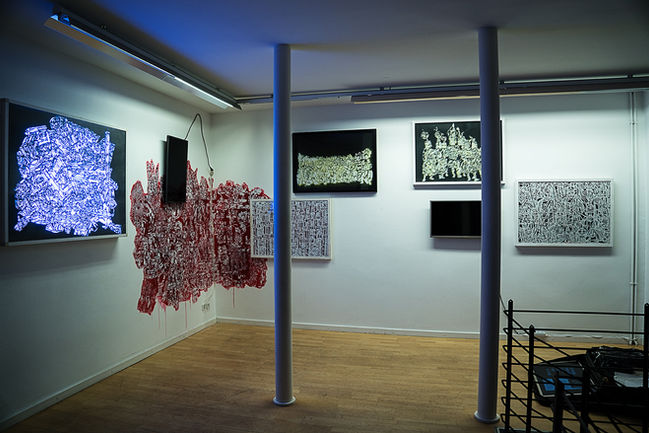LIVIL
SHUFFLE REPEAT
Text by Esther Mlenek The almost obsessive repetition of similar images or motifs, or the actual serial production, is a specific characteristic of Olivier Hölzl's art. It allows the Austrian artist to filter image content from the pool of media-related challenges and create independent objects with rudimentary or taxonomic structures. Hölzl incessantly accumulates everyday items, photos, and newspaper clippings, which he compiles into material collections and comprehensive artist books. He also emulates the vast online archives of Google, Instagram, and others by capturing their totalizing, symbolic order. The eye of Olivier Hölzl's image hurricane forms the cut-out of the NSA headquarters in Maryland, US. It appears as if the facility has spat out the exhibited collages, videos, and object arrangements through the cut-outs in the meticulously crafted paper wall - notably the "Pirates, terror tuberculosis" and "Cain and Abel" from the eponymous video "NSA." Adorned with another three hundred key terms from the US Department of Homeland Security, the two works depict a group portrait of a global community increasingly displeased with accepting the natural complexity of things. As the fragmentation of content fueled by digital pace spills over into contemporary art, Olivier Hölzl showcases with "DOCUMENTA." The arguably most important fair in an international context has been criticized in recent editions as a "place of substitute actions, boundless in ambition, yet politically apolitical." Despite ambivalence, but without internal conflicts, one could also preface Hölzl's statement with this sentence. The artist disassembled ten books from Documenta 13, reduced the descriptions of artistic positions to essential information, and cut out corresponding sentence fragments as templates. The incongruence between what was seen in the exhibition context and what was described in countless texts, whether falsely or not, prompted the artist to blacken them in favor of a clearly dubious clarity. With this microscopic view, the artist also becomes an investigating commissioner, allowing his "Voices in the Dark" to proclaim the Whole Truth from a web of lies: In "CRIME," the associative richness of combining text passages and images from American whodunit and murder-mystery series creates a network of visual structures, layers, and overlays of information and gossip units. Throwing various images and codes from popular culture, the compilation illustrates no further argument. Rather, it presents the present not so much pictorially as granularly. And the Whole Truth? Especially in a world inundated with stimuli, there can be no clarity. To move away from hasty agreements, Olivier Hölzl's collections therefore take on the topography of a landscape in which visitors lose sight of the horizon. Shuffle repeat. The artist picks up the pace. To the drumbeat of O.L.F., yams, baobab seeds, and nimble cranes swarm densely once again in the stop-motion video "SENEGAL" against a white background. To be able to continually and spontaneously expand his archive, Hölzl drags a digital camera and a photo tent like trawling nets through the immediate surroundings. During his travels through Senegal, he developed a finely tuned radar for cultural and social traces that seem so marginal and everyday that they can hardly be registered as relevant. In the collection of around 2,500 individual shots that make up the stop-motion video, Olivier Hölzl stages the "cultural compost" with historical research sensitivity, blending irony with a passion for his world, and nostalgia with a love for the contemporary. In all works, particularly strikingly in "SENEGAL," it becomes visible that collecting and archiving itself takes on an aesthetic dimension. Despite rapid image sequences and wild mixtures, Olivier Hölzl is a protagonist of an art that takes its time, addresses human uprooting through the culture of progress, and places it in a symbolic, aesthetic, and ontological context. It is solely the task of the viewers to navigate through Hölzl's dense image and text structures, conduct aesthetic research, and find their own meaning for things following the inner rhythm.










